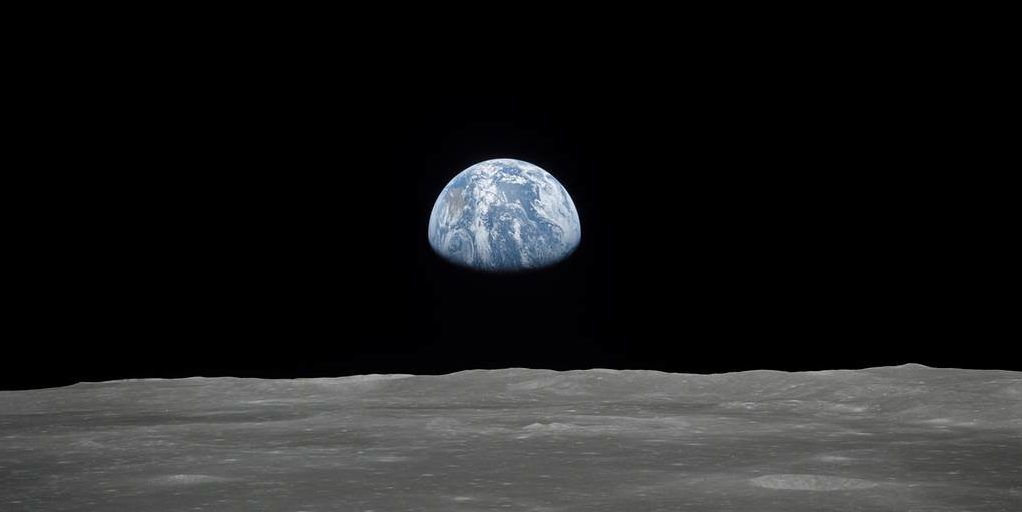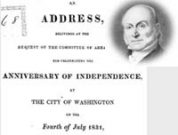A Giant Leap, Fifty Years On
On July 16, 1969, American astronauts Neil Armstrong, Edwin “Buzz” Aldrin, and Michael Collins lifted off from Cape Canaveral and rocketed into space atop the massive three-stage Saturn V destined for the moon. On July 20, Armstrong and Aldrin made history by landing on the moon while Michael Collins orbited above. Armstrong was the first to walk on the moon and uttered the historic words, “That’s one small step for man. One giant leap for mankind.”
The moonshot has been interpreted in many ways over the past fifty years, but it is universally acknowledged that the Mercury, Gemini, and Apollo programs directed by NASA were a front in the Cold War against the Soviet Union to prove the superiority of American brainpower and technology as well as the system of democratic freedom.
The astronauts who dared space were a courageous and heroic lot. Early on, they were seen by writers such as Tom Wolfe as adventure-seeking fighter jocks who enjoyed pushing the limits of human endurance. More recently, Craig Nelson and other authors have seen them through the lens of test pilots and highly-educated engineers who were deliberative and level-headed problem-solvers.
The focus of many recent books shifts the story in part away from the astronauts themselves to look at the incredible collaborative effort of more than 400,000 people from across thousands of corporations and government agencies in the military-industrial complex. Visionary scientists and engineers developed ideas and made them a reality. Government agencies like NASA navigated the politics of Congress for funds and the in-fighting of the federal bureaucracy. Corporations received government contracts and helped to change the American landscape by contributing to the rise of the Sunbelt.
The $25 billion-dollar cost of Project Apollo alone raised many eyebrows during a time when spending a few billion dollars annually was a relatively significant part of the federal budget. Many contemporary critics and writers since have wondered whether it was safer and cheaper to send unmanned probes into space, or questioned the entire project of space exploration. Defenders of manned space exploration point out the technological benefits that accrued from it, and more importantly, the indomitable spirit of human discovery that is built into the fabric of our nature.
In American Moonshot, historian Douglas Brinkley adds a new dimension to understanding the significance of the lunar program. Like Walter McDougall in …The Heavens and the Earth, Brinkley narrates the political history of the space age. He focuses on Kennedy and his administration and how the New Frontier was tied to space exploration.
Brinkley contends that the importance of the lunar program lies in the organization of a large public-works project that harnessed the power of an activist federal government akin to the Interstate Highway System or New Deal projects. He praises the projects as a “shared national endeavor” that united Americans and led to the progressive “forward march of progress.”
Popular historian James Donovan narrates the more traditional story of the space race of the late 1950s and 1960s in his new book Shoot for the Moon. Donovan is a masterful storyteller who captures the heroism of the astronauts and the collective effort that led to the success of the American moon landing. He tells a very human story and makes the readers feel as if they are witnessing events as they unfold dramatically.
While the two books cover much of the same ground, their approach is quite different. Brinkley sees Kennedy as the youthful and forward-looking politician who embodied the dynamism of the New Frontier and the quest for the moon. Donovan offers a fast-paced, character-driven narrative in which individuals are playing roles in historic events.
The story begins with the launching of Sputnik in 1957 as a shot across the bow in the space race even if it was only a modest metal sphere that beeped a signal back to earth. Although President Dwight Eisenhower downplayed its significance and wanted to avoid a costly space race, popular and political hysteria overcame Ike’s caution.
Congress sprang into action and quickly passed the National Defense Education Act to fund math and science education and established NASA to oversee the space program. Over the next few years, Americans were frustrated that the Russians continually beat them into space with a series of “firsts.” American global prestige and exceptionalism seemed at stake especially to politicians who did not want to appear to fall behind the communists.
Brinkley argues that Eisenhower lacked the imagination and vitality—the willingness to pursue a grand vision. Kennedy supplied that in abundance but brought with it a faith in technical know-how. He lauds the “best and the brightest” technocrats of the New Frontier whose forward-thinking vision of “adventure, curiosity, big technology, cutting-edge science, global prestige, American exceptionalism” led to success in the space race. However, a critic might point out that these same visionaries contributed to the nuclear arms race and a growing commitment to South Vietnam. Brinkley ignores how these ideals had a darker side of global adventurism and involved the United States in war during the Cold War.
Human spaceflight was only made possible by the pioneering efforts in rocket technology by American Robert Goddard, German Hermann Oberth, and Russian Konstantin Tsiolkovsky. The American rocket program however was dominated by the personality of visionary scientist and inveterate space promoter, Wernher von Braun. He was a former Nazi scientist who had overseen the development of the V-2 rockets before being smuggled into the United States with 120 other German scientists, 100 V-2 rockets, and thousands of pounds of blueprints.
Von Braun was at least complicit in thousands of British civilian deaths and victimized tens of thousands of forced laborers who worked in the factories producing Nazi rockets. While his complex role in the Nazi regime should not be obscured by his heroic and innovative contributions to American rocketry, Brinkley relentlessly plays the role of prosecuting attorney and labels the German scientist “Hitler’s agent of mass destruction.” He also fails to see how the technocratic utilitarianism that drove von Braun’s work for the Nazi regime resembled the mentality underpinning the best and the brightest. Donovan acknowledges von Braun’s past and moves on.
Donovan focuses on the drama of the American spaceflights and the experience of the astronauts. Soviet cosmonaut Yuri Gagarin’s flight as the first human in space was followed closely by astronaut Alan Shepard. Donovan highlights the dangers of early space exploration: While Americans did not lose anyone in space, several flights experienced significant challenges. Gus Grissom’s Liberty Bell 7 sank in the ocean, John Glenn’s heat shield was not locked on during reentry, Scott Carpenter failed to prepare his craft for the right angle for reentry, and Armstrong and Dave Scott barely recovered from an uncontrollable spin after a successful docking in Earth’s orbit during Gemini 8.
After the successful launch of the Mercury program, Kennedy delivered his Rice University address pledging to put a man on the moon by the end of the decade. Kennedy stated:
We choose to go to the moon—we choose to go to the moon in this decade and do the other things, not because they are easy, but because they are hard, because that goal will serve to organize and measure the best of our energies and skills, because that challenge is one that we are willing to accept, one we are unwilling to postpone, and one which we intend to win.
With some hyperbole, Brinkley argues the speech “ranks among the most inspiring ever delivered by an American president,” because it gave Americans a spirit of common purpose.
Donovan explains that America’s space program certainly stirred the American imagination. They read about the lives of the astronauts and their families in Life and other magazines, attended ticker-tape parades in New York and local parades honoring the astronauts, and watched as astronauts delivered speeches to Congress or visited the White House. They watched the launches on television with commentary by broadcasters such as Walter Cronkite, and more than one million people witnessed the Apollo 11 launch.
Since Brinkley imagines the space program as a grand infrastructure project, it is perhaps unsurprising that he conceives American citizens primarily as taxpayers who contributed their share of revenue to the collective effort. He writes, “Fifty million people could see their tax dollars at work, watching the moonshot draw closer to success with each ensuing launch. No exploration in human history had been so democratic.” It is hard to believe that millions of Americans and others around the globe were thrilled watching astronauts blast into space through the lens of paying taxes.
On January 27, 1967, Grissom, Ed White, and Roger Chaffee died in an Apollo 1 test simulation. The investigations launched by a review board and by congressional hearings were honest and thorough self-criticism that resulted in systematic change. Both authors point out that it was only possible in a free and open democratic society. On the other hand, the closed Soviet society launched missions secretly and covered up several accidents.
In the wake of the Apollo 1 disaster, the United States surpassed the Soviets in the space race as the USSR’s scientists reached the limitations of their technological progress. Meanwhile, the Apollo program rapidly mastered key missions such as rendezvous in space and circumnavigating the moon.
By July 1969, the United States landed on the moon. The astronauts planted an American flag as a symbol of patriotism and a plaque that expressed the larger common purpose of humanity in discovery. Today, India, China, Russia, and the United States have plans to land on the moon for resource exploration and a base for space exploration to Mars and other distant objects. Debates over the desirability of returning to the moon are reflected in the two books. Would Donovan’s vision of pushing the limits of human endurance and knowledge through discovery be met by returning to an old frontier already explored and would it be worth the cost? Would Brinkley’s vision of an interplanetary infrastructure project and a New Deal of sorts for the solar system really unite Americans during a time of fierce political divisions over the purposes of the government and federal spending? Would Americans be inspired by a privatized commercial moon landing like they were fifty years ago when accomplished by NASA?
Whatever our answers to these questions, the fiftieth anniversary of Apollo 11 is a time for honoring that human spirit that drives us to extraordinary achievements previously thought impossible.
Editor’s Note: We recommend you visit NASA’s “live” video and audio presentation of the entire Apollo 11 mission.



